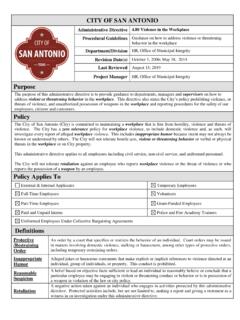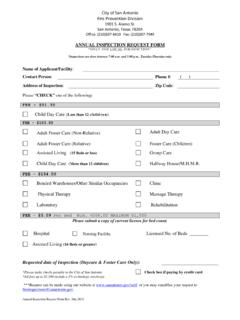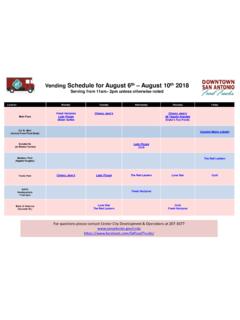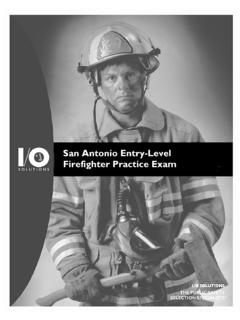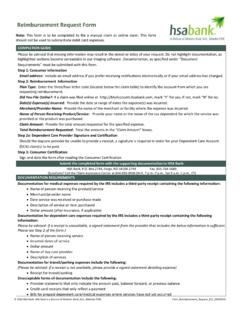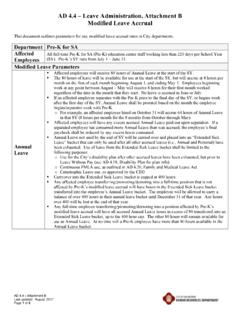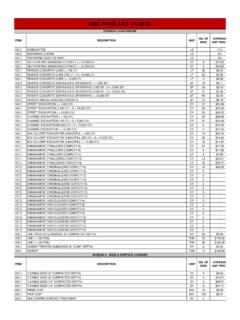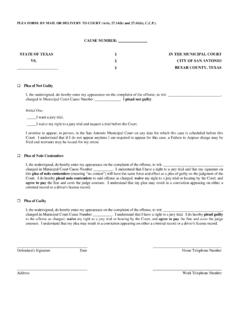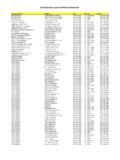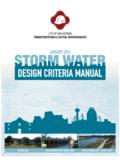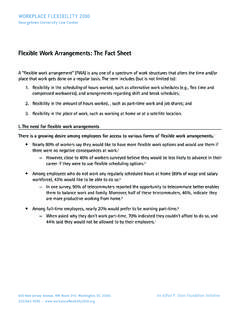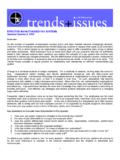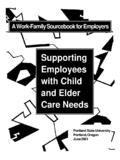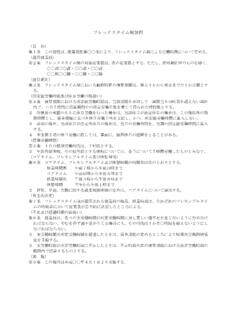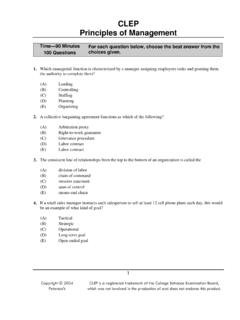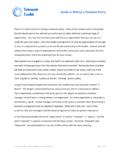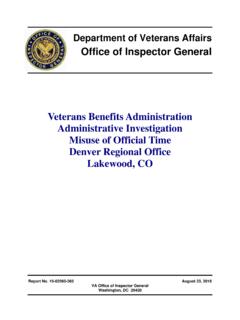Transcription of CITY OF SAN ANTONIO
1 city OF SAN ANTONIO Administrative Directive AD Workplace Attendance Procedural Guidelines Guidelines to ensure consistent application of attendance policies and procedures Department/Division Human Resources/Employee Relations Effective Date October 1, 2006 Revision Dates October 1, 2014; October 1, 2016 Last Reviewed N/A Owner HR Employee Relations, Assistant Director Purpose The purpose of this administrative directive (AD) is to establish citywide standards and guidelines for effective absence management of classified and unclassified civilian employees. Policy Employee attendance is critical for the effective delivery of city of San ANTONIO ( city ) services to our citizens and excessive absenteeism challenges any organization s ability to meet its goals and objectives. Therefore, employees are relied upon to attend scheduled work on time or give reasonable notice when they are not able to attend work. Leave provisions related to the Family & Medical Leave Act, Workers Compensation Program, Military Leave/USERRA, Extended Disability Plan, or other absences protected by federal or state law, are described in separate ADs, and are not subject to the provisions of this AD.
2 Policy Applies To External & Internal Applicants Temporary Employees on the city s Payroll Full-Time Employees Volunteers Part-Time Employees Grant-Funded Employees Paid and Unpaid Interns Police and Fire Academy Trainees Uniformed Employees Under Collective Bargaining Agreements Definitions Alternative Work Schedules (AWS) A term for a fixed work schedule that may be outside the normal work hours for a position. The resulting work schedule will have the same number of hours as is normally required for any given pay period. For example, if a typical work schedule for a position is 8:00 AM 5:00 PM, Monday Friday, an AWS might be 7:00 AM 6:00 PM, Monday Thursday. Attendance Cycle Each six month period from October 1 through March 31, and April 1 through September 30, of each fiscal year. Civil Emergency A state of emergency declared by the President, Governor, or the Mayor. Departmental Attendance Procedures Internal attendance procedures established by each department.
3 Flextime for Exempt Employees The ability for a supervisor to make a temporary alteration to an exempt (salaried) employee s regular work schedule. Notice of Leave Self entry into the time/payroll system or a form required for an employee to submit request for scheduled leave or document unscheduled leave taken. 2 Scheduled Start Time The beginning of an employee s shift and the time the employee is required to return from break, lunch period or other approved absence from the workplace. Time and Attendance Specialist (TAS) A city Employee responsible for performing various time management-related functions, including collecting, entering, validating, and analyzing data. This position reports to the Finance Department. Working days Calendar days, excluding Saturdays, Sundays and Council-approved holidays. Workweek The period of time beginning at 12:01 AM Saturday and ending 12:00 Midnight Friday. Policy Guidelines 1. Scheduled Leave requests must be made in advance through the submission of a completed Notice of Leave.
4 An employee may select the applicable leave to be charged for an absence. 2. An employee is required to request and schedule leave in advance with supervisory personnel, and must confirm approval prior to taking leave. The employee must complete and submit to the supervisor the Notice of Leave prior to any scheduled absence. Unscheduled absences must be documented on the Notice of Leave promptly upon the employee s return to work. 3. Upon receipt of the employee s Notice of Leave, the supervisor is required to approve or deny the request as soon as possible. 4. The supervisor will provide the employee with a copy of the approved or denied Notice of Leave when a notice of leave has been submitted on a paper form. The approved form will be forwarded to the TAS for processing. 5. Approved leave may not be rescinded by the department without the Department Director s (or designee s) approval. Leave requested and approved more than 60 days in advance shall not be rescinded unless a Civil Emergency is declared.
5 6. A department may identify mandatory work cycles in which increased operational needs may prohibit the granting of leave. These periods shall not exceed 80 days per fiscal year unless a Civil Emergency is declared. 7. Workplace absences during inclement weather shall be managed as directed by the city Manager s Office for each occasion. 8. An employee shall make personal contact with designated supervisory personnel to request leave, unless otherwise incapacitated by illness or injury. 9. To avoid hardship to an employee who relies on public transportation or who faces other special circumstances, the department may adjust the employee s work schedule for both starting and ending time provided the total amount of hours worked is equivalent to the employee s normal work hours. The employee must request the adjustment in writing and provide adequate documentation for the special circumstances. In cases involving public transportation, the employee shall provide a bus schedule to indicate that no bus arrives within a half hour prior to the employee s scheduled start time.
6 A Department Director (or designee) maintains authority to determine whether this adjustment may be accommodated based upon the department s workload and operational mission. 10. An unauthorized absence of two working days is considered a voluntary resignation as defined in Section 2 of Rule XVII of the Municipal Civil Service Rules. 11. The supervisor shall consult with the departmental HR Representative or Human Resources Department prior to the assessment of any disciplinary action. 12. Employees who fail to submit a Notice of Leave are subject to disciplinary action for failing to follow instructions. 13. Non-exempt employees who accumulate 30 attendance points within an attendance cycle, or who demonstrate habitual tardiness and/or absenteeism by accumulating 26 or more attendance points in four (4) consecutive attendance cycles, are subject to termination as defined in Section 2 of Rule XVII of the Municipal Civil Service Rules.
7 3 Absence Management Exempt Employees Absence management for employees who are classified as exempt under the rules of the Fair Labor Standards Act (FLSA). 1. Supervisors should counsel and, when necessary, take corrective action against an employee who develops a habitual pattern of excessive unscheduled absence or tardiness. Additionally, employees can be assessed discipline for excessive absenteeism or tardiness in accordance with AD , Coaching and Discipline. 2. All disciplinary actions should be coordinated with the assigned HR Representative or the Human Resources Department. Non-Exempt Employees This section applies to employees who are classified as non-exempt under the rules of the FLSA and who hold classified Civil Service positions. Department Directors have the discretion to apply the attendance point system and associated discipline to non-exempt unclassified employees (such as grant funded employees and executive secretaries), part-time employees, and temporary employees on the city s payroll.
8 1. Attendance infractions shall be tracked by a system that assesses points for absences defined by this AD within prescribed attendance cycles. 2. An employee is required to request time off in advance, prior to the scheduled start time, and as prescribed by the employee s department attendance procedures. 3. Upon the request for time off, an employee may be required to provide documentation for unscheduled absences of three consecutive days or more. 4. An employee may request that more than one absence from work within three days for the same condition or emergency be considered a single event for the purpose of assessing points, if the condition was beyond the employee s control. The supervisor may request appropriate documentation to substantiate the condition or emergency. A doctor s note related to the employee s own illness will suffice to grant a single event absence. All other requests of this nature require approval from the Department Director (or designee).
9 The Director s determination of such a request is final. 5. An employee may be required to provide documentation within three days of returning to work to substantiate leave for jury duty, a funeral or memorial service, or to provide support for an unscheduled absence during a mandatory work cycle. Examples of documentation include jury notice, copy of obituary, etc. 6. Lunch periods are normally scheduled for 45 minutes, unless modified by the department. These lunch periods are not paid. Non-exempt employees must be completely relieved from duty during lunch periods. It is considered work time if an employee performs duties during lunch periods. A non-exempt employee is also granted two paid 15 minute breaks per eight hour shift. When department workload does not permit the granting of breaks, the city accrues no liability for overtime or compensatory time for lost breaks.
10 At the supervisor s discretion, an employee may combine his/her lunch and break periods. 7. Based on operational reasons, an employee reporting to work one hour or more following the employee s scheduled start time may be sent home by the supervisor, with accrued leave or leave without pay if no applicable leave is available. 8. An employee shall be assessed points for absenteeism, tardiness and time clock infractions as follows: 4 POINTS ASSESSMENT TABLE Assessment Category Points Assessment Category Definition Compliance Attendance Points Time Clock Infraction Failing to punch-in or out when arriving or leaving work First two infractions within an attendance cycle N/A 1 each Three or more infractions within an attendance cycle 2 each Tardy (Type A) Reporting to work within one hour of scheduled start time In accordance with Departmental Attendance Procedures 1 Tardy (Type B) Reporting to work within one hour of scheduled start time In violation of Departmental Attendance Procedures 2 Late Report/Early Departure (Type A) Reporting to work more than one hour after scheduled start time but with at least half of the shift remaining In accordance with Departmental Attendance Procedures & when employee has sufficient leave to cover time off 2 Leaving work during a shift after notifying a supervisor Late Report (Type B)
